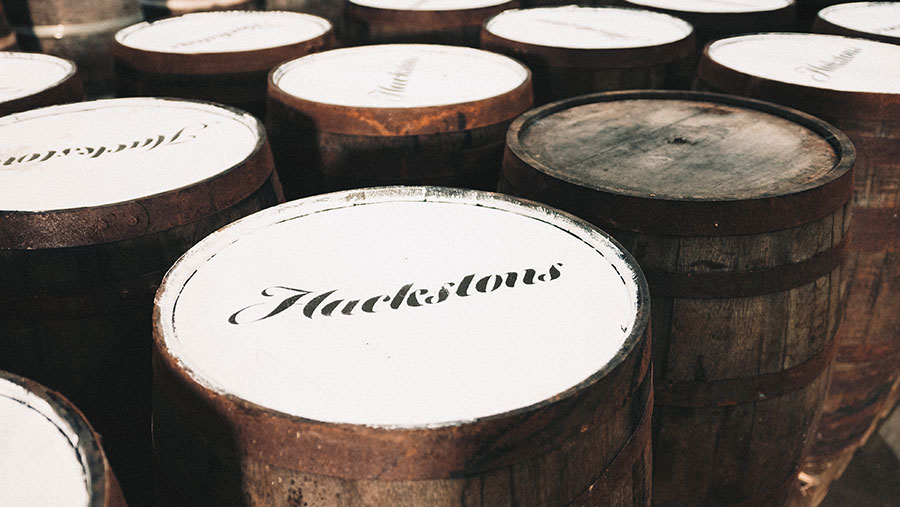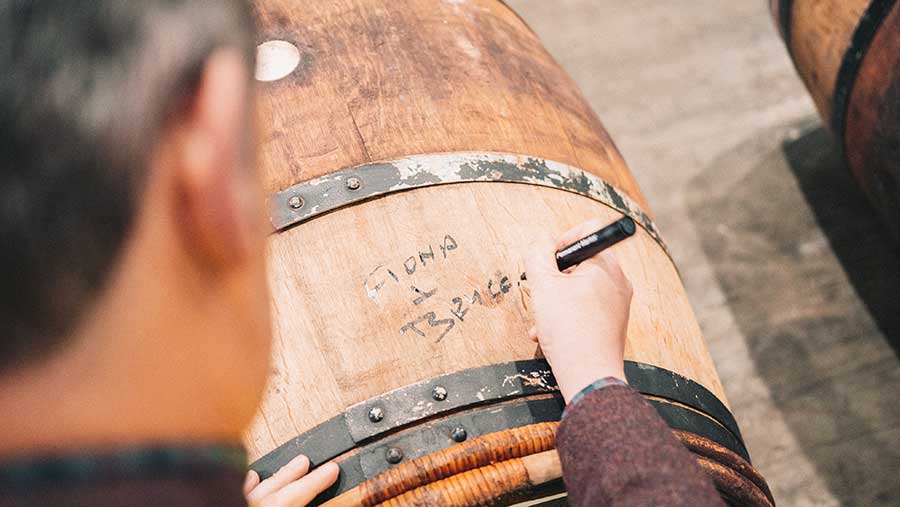Advertiser content
Diversify your farm income with cask whisky investment
This time last year, the Chancellor’s Autumn Budget confirmed that major changes to Inheritance Tax (IHT) will take effect from April 2026, and these changes are set to have a real impact on farmers and rural business owners.
For many years, agricultural and business assets have benefited from generous tax reliefs when passed down through families. From 2026, however, only a portion of those assets will remain fully protected.
In addition to reassessing their business and tax structures, farmers are exploring alternative investments such as cask whisky ownership. While it might sound unusual at first, this approach offers an opportunity to diversify, protect value, and plan for the next generation in a different way.
Risks and points to consider
Hackstons prioritises transparency when it comes to investment and so here’s some key things to consider. Ultimately, no investment is without risk, and cask whisky is no exception.
No guaranteed returns: Just like every market, the value of whisky can rise or fall depending on market trends and global demand. Past performance should never be taken as a guarantee of future results.
Do your research: Not every cask company operates to the same standard. It is important to check credentials, read reviews, and where possible meet representatives in person. Always verify ownership documentation and ensure casks are stored in legitimate bonded warehouses.
Limited liquidity: The cask market is smaller and more specialised than traditional investments. Selling a cask can take time and may require patience.
Not a substitute for professional planning: While cask whisky can certainly be a useful part of a diversified strategy, it cannot replace tailored advice from tax, financial, or legal professionals.
Financial regulation: Currently in the UK cask whisky investment is not authorised or regulated by the FCA Financial Conduct Authority.
For those already exploring diversification through renewable energy or rural business ventures, whisky casks may add another layer of value, but the same due diligence and long-term thinking should always apply.

© Hackstons
The new rules from April 2026
- From 6 April 2026, a new limit will apply. Individuals and trusts will be able to claim 100% relief on up to £1 million of qualifying agricultural or business assets.
- Any value above that threshold will instead qualify for 50% relief. This means that the remaining 50% of the excess will become subject to inheritance tax, creating an effective 20% tax liability on the portion that would previously have been fully relieved.
- The government is also proposing to make assets eligible for BPR and APR (added together) count towards the £1 million cap.
- The £1 million allowance will apply separately to each individual or trust, but it cannot be transferred between spouses or civil partners. In other words, each person will have their own limit. This limit will refresh every 7 years.
This allowance will also cover certain lifetime transfers and gifts made after 30 October 2024 for anyone who passes away on or after 6 April 2026. For trusts, a similar £1 million limit will apply for periodic and exit charges.
Why this matters for farmers
The government insists that these new rules are aimed at the wealthiest estates and are designed to close tax loopholes, but many within the farming community are concerned that this shift could place extra strain on family farms and long-term food security across the UK.
Under the current law, many farming assets qualify for 100% relief from Inheritance Tax through Agricultural Property Relief (APR) and Business Property Relief (BPR).
This means that farmland, farm buildings, machinery, and certain business assets can be passed down or gifted without attracting IHT, provided they meet the relevant conditions such as being occupied and used for genuine agricultural purposes.
At present, there is no upper limit on the amount of qualifying assets that can benefit from this full relief.
In some cases, BPR can also extend to trading businesses, including shares in unquoted trading companies, allowing those assets to be passed on completely free of Inheritance Tax.
The implications for farm succession and long-term planning are significant. Many farms easily exceed £1 million in total value once land, buildings, machinery, and the business itself are considered together.
For some family farms that were previously tax free, a portion of their estate may now attract Inheritance Tax on the excess value beyond the new limit.
As a result, some families could face a tax bill for the first time when transferring their farm to the next generation.
This change also increases the importance of timing and ownership structure. Farmers will need to think carefully about how assets are distributed, whether through lifetime gifts, trusts, or other arrangements.
Because the £1 million limit cannot be shared between spouses, planning how ownership is divided could make a real difference to the relief available.
Trusts will also become less flexible, as the new cap applies in the same way to trust-held assets.
The government’s intention is to ensure that reliefs are “better targeted”, reducing benefits for the very largest estates.
For some, the best approach may be to take action before the deadline. Farmers who are in a position to restructure before April 2026 could benefit from the current, unrestricted rules.
Even where partial relief still applies, the resulting tax bill could create cash flow challenges.
Although instalment options exist for paying IHT over time, the estate must still have sufficient liquidity to meet those payments.
Looking beyond the farm: The role of alternative investments
With these changes approaching, some farmers are looking at ways to spread risk and create additional forms of wealth that sit outside traditional agricultural assets. One area gaining interest is cask whisky investment.
At first glance, whisky might seem far removed from farming, but there are similarities that appeal to those familiar with long-term, tangible value. Cask whisky is a physical product that matures over time, and as it does, its value can grow.
The appeal of cask whisky
Tax efficiency: While it matures in its cask, whisky is considered a “wasting asset” by HMRC due to the natural evaporation that occurs during ageing, known as the Angel’s Share. Because of this, it is exempt from Capital Gains Tax. If however the whisky is bottled the process will be subject to Duty, VAT and potentially CGT.
Legacy potential: Many investors view cask whisky as a long-term or even generational investment. As whisky matures, both its rarity and its market value tend to rise, which makes it attractive to those who want to preserve wealth for their families.
Built-in scarcity: Genuine Scotch whisky must be distilled and matured in Scotland for at least three years, and production cannot simply be increased overnight. That controlled supply supports long-term value growth.
Not linked to financial markets: Cask whisky prices generally move independently of stock markets or agricultural commodity prices, offering an alternative asset that can help balance a portfolio.
Low maintenance: Unlike farmland or property, owning a cask requires little attention. Apart from occasional checks or re-gauging (checking the cask’s contents for ABV levels), the investment is largely hands off.
For farmers who are used to assets that require constant care and maintenance, the appeal of a self-contained, quietly maturing investment can be strong.

© Hackstons
Practical steps for farmers before 2026
Review asset values: Calculate the combined value of farm and business assets to identify any exposure above the £1 million relief limit.
Plan ahead of the changes: Planning is crucial, consider restructuring before April 2026 to take advantage of the current rules.
Reassess joint holdings: Allowances cannot be transferred between spouses, review how ownership is structured within the family.
Explore diversification: Consider assets outside the core farm business that could support long-term planning goals, such as cask whisky.
Seek professional advice: Consult with accountants, solicitors, and tax specialists to ensure decisions are well informed.
Involve the next generation: Open communication and transparency with family members helps to ensure everyone understands the plan for the farm’s future, helping to preserve unity and continuity.

© Hackstons
Conclusion
From April 2026, it looks increasingly likely that Inheritance Tax rules will limit the reliefs that have long supported family farms. And for many, this is a turning point that calls for proactive planning and open-minded thinking.
This means reviewing assets, structuring ownership carefully, and considering alternative ways to hold and protect wealth that can make a significant difference.
Cask whisky is a tangible and time-based asset that offers opportunity for diversification. While it is indeed not a substitute for professional tax planning, it can play a supporting role in building a long-lasting legacy.
If you would like to know more about cask whisky ownership get in touch with Hackstons here.
Provided by
Hackstons are redefining the luxury tangible goods market, offering a taste of excellence through curated collections of rare whiskies, fine wines, and exclusive spirits. Founded in 2021 with a focus on cask whisky ownership, our business allows clients to explore whisky as both a consumable and a long term investment. With end-to-end services, from acquisition and storage to bottling and resale, Hackstons is a one-stop destination for collectors, connoisseurs, and investors alike.
